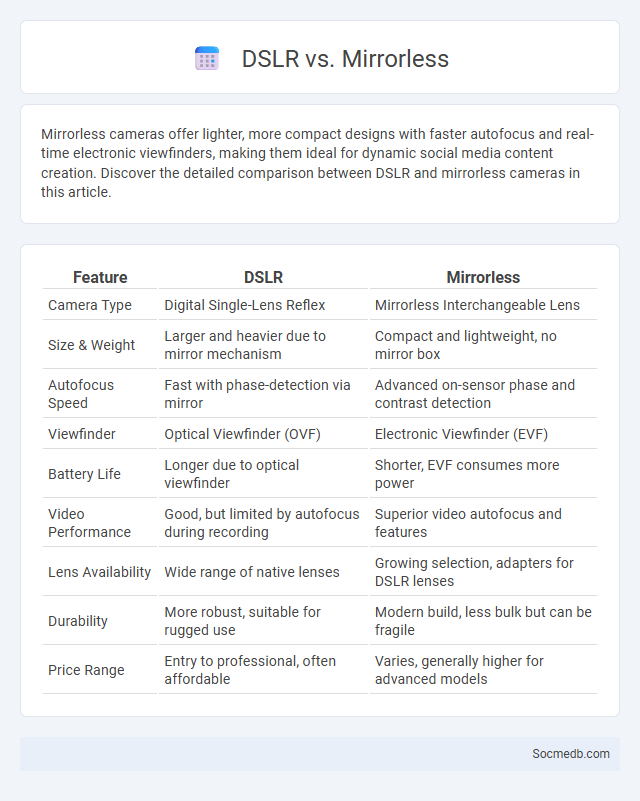
Photo illustration: DSLR vs Mirrorless
Mirrorless cameras offer lighter, more compact designs with faster autofocus and real-time electronic viewfinders, making them ideal for dynamic social media content creation. Discover the detailed comparison between DSLR and mirrorless cameras in this article.
Table of Comparison
| Feature | DSLR | Mirrorless |
|---|---|---|
| Camera Type | Digital Single-Lens Reflex | Mirrorless Interchangeable Lens |
| Size & Weight | Larger and heavier due to mirror mechanism | Compact and lightweight, no mirror box |
| Autofocus Speed | Fast with phase-detection via mirror | Advanced on-sensor phase and contrast detection |
| Viewfinder | Optical Viewfinder (OVF) | Electronic Viewfinder (EVF) |
| Battery Life | Longer due to optical viewfinder | Shorter, EVF consumes more power |
| Video Performance | Good, but limited by autofocus during recording | Superior video autofocus and features |
| Lens Availability | Wide range of native lenses | Growing selection, adapters for DSLR lenses |
| Durability | More robust, suitable for rugged use | Modern build, less bulk but can be fragile |
| Price Range | Entry to professional, often affordable | Varies, generally higher for advanced models |
Introduction to DSLR and Mirrorless Cameras
DSLR and mirrorless cameras represent the pinnacle of quality for social media content creators seeking high-resolution images and professional video capabilities. DSLR cameras utilize an internal mirror mechanism to reflect light through the lens into an optical viewfinder, providing photographers with real-time image previews. Mirrorless cameras, on the other hand, eliminate the mirror system for a more compact design, relying on electronic viewfinders and offering faster autofocus and better live view performance for dynamic social media content.
What is a DSLR Camera?
A DSLR camera is a digital single-lens reflex device that uses a mirror mechanism to reflect light from the lens to an optical viewfinder, offering high-quality images with greater control over exposure, focus, and depth of field. Social media content creators prefer DSLRs for their superior image resolution, manual settings, and interchangeable lenses, which enhance the visual appeal of photos and videos. Your ability to capture professional-grade visuals with a DSLR significantly boosts engagement and follower growth on platforms like Instagram and YouTube.
What is a Mirrorless Camera?
A mirrorless camera is a digital camera that uses an electronic viewfinder instead of a traditional optical viewfinder, eliminating the mirror mechanism found in DSLR cameras. These cameras offer compact designs, fast autofocus, and high-quality image sensors ideal for social media content creators who require portability and superior photo and video quality. Mirrorless cameras are increasingly popular for capturing vibrant, sharable images and videos on platforms like Instagram, TikTok, and YouTube.
Key Differences Between DSLR and Mirrorless
DSLR cameras utilize a mirror mechanism to reflect light through an optical viewfinder, providing real-time, lag-free image preview, while mirrorless cameras rely on electronic viewfinders or LCD screens for framing. Mirrorless cameras are typically more compact and lightweight due to the absence of a mirror box, enhancing portability for social media content creators. Autofocus performance in mirrorless systems often benefits from advanced on-sensor phase detection, offering faster and more accurate focusing compared to traditional DSLR models.
Image Quality Comparison
High-resolution images significantly enhance your social media presence by capturing attention and increasing engagement rates. Platforms like Instagram and Facebook optimize image compression differently, affecting clarity and detail visibility. Ensuring your images meet each platform's recommended dimensions and formats preserves quality and boosts visual impact.
Autofocus and Performance
Social media platforms utilize advanced autofocus technology to enhance the quality of user-generated content by improving image clarity and ensuring sharp focus on subjects. Optimized autofocus algorithms enable faster response times and better object tracking, which significantly boosts overall performance during live streaming and video recording. This combination of autofocus precision and high-performance processing contributes to a more engaging and visually appealing social media experience.
Size, Weight, and Portability
Social media platforms offer unparalleled accessibility through mobile devices, allowing you to stay connected regardless of size or weight constraints. Lightweight apps designed for smartphones optimize battery life and performance, enhancing user experience while on the go. Portability ensures your social media interactions are seamless, enabling instant sharing and engagement anytime, anywhere.
Lens and Accessory Compatibility
Lens and accessory compatibility is crucial for maximizing the potential of social media content creation, ensuring creators can use a variety of lenses to enhance image quality and achieve desired effects across different devices. Social media platforms often demand high-resolution visuals; therefore, using compatible lenses designed for specific smartphones or cameras optimizes sharing and viewer engagement. Accessory compatibility, including tripods, stabilizers, and external microphones, further elevates production value, allowing seamless integration that meets the dynamic needs of influencers and digital marketers.
Battery Life and Durability
Social media usage significantly impacts your device's battery life, with constant notifications and video streaming accelerating power drain. Durable smartphones are designed with advanced battery management systems and robust materials to withstand prolonged social media activity without compromising performance. Prioritizing devices with enhanced battery capacity and reinforced build quality ensures seamless social media interaction and long-term reliability.
Choosing the Right Camera: Which Suits Your Needs?
Selecting the right camera for social media depends on your content style, budget, and technical skills. Mirrorless cameras like the Sony A7 III offer excellent image quality and versatility for photographers seeking high resolution and low-light performance, while smartphones such as the iPhone 14 Pro provide convenience and advanced computational photography features ideal for quick, on-the-go posts. Understanding factors like sensor size, lens compatibility, video capabilities, and user interface helps ensure the camera aligns with your creative goals and content frequency.
 socmedb.com
socmedb.com